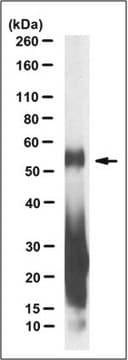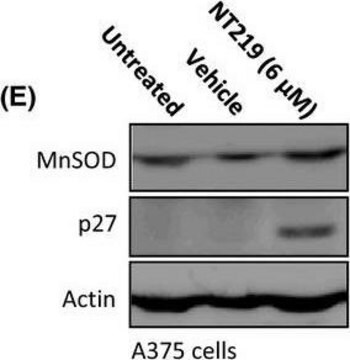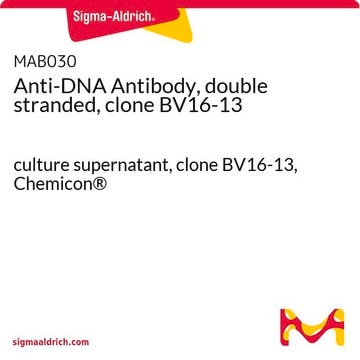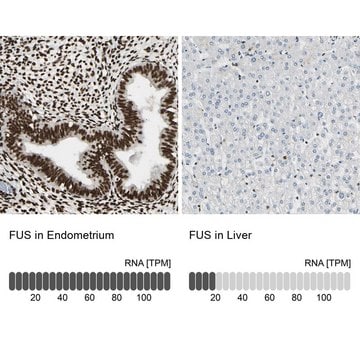推荐产品
生物源
rat
品質等級
抗體表格
purified antibody
抗體產品種類
primary antibodies
無性繁殖
5A2, monoclonal
物種活性
human
物種活性(以同源性預測)
all
濃度
1 mg/mL
技術
immunohistochemistry: suitable
western blot: suitable
同型
IgG2aκ
運輸包裝
wet ice
目標翻譯後修改
unmodified
基因資訊
human ... C9ORF72(203228)
一般說明
C9ORF72非编码区中的六核苷酸(GGGGCC)重复扩增是FTD和ALS(c9FTD/ALS)的主要遗传原因。GGGGCC重复序列的RNA结构使这些转录本易受翻译重复—序列相关的非ATG(RAN)翻译的非常规机制的影响。GGGGCC重复序列在所有阅读框中的翻译将产生三种二肽重复(DPR)蛋白poly-(Gly-Ala)、poly-(Gly-Pro)和poly-(Gly-Arg)。poly-GA和poly-GP蛋白具有极强的疏水性,可能形成细胞内聚集体
特異性
该抗体识别C9ORF72/C9RANT(poly-GR)和其他含有poly-GR序列的蛋白,如EB病毒蛋白EBNA2
免疫原
对应于包含GR重复序列的EB病毒核抗原2(ENBA2)的线性肽。
表位:poly-GR
應用
使用经验证可用于蛋白质印迹&IHC的抗C9ORF72/C9RANT(poly-GR)抗体(克隆5A2)检测C9ORF72/C9RANT(poly-GR)。
免疫组织化学分析:一个代表性批次在具有C9ORF72六核苷酸扩增的C9orf72患者的脑组织中检测到poly-GR包涵体(Mori,K.,et al.(2013).Science.339(6125):1335-1338.)。
研究子类别
神经退行性疾病
神经退行性疾病
研究类别
神经科学
神经科学
品質
通过蛋白质印迹法使用具有15个GA、GP或GR重复序列的GST融合蛋白以及不具有任何重复序列的单独GST进行评估。
蛋白质印迹分析:0.2 μg的该抗体检测10 μg具有15个GR重复序列的GR-GST重组蛋白。
蛋白质印迹分析:0.2 μg的该抗体检测10 μg具有15个GR重复序列的GR-GST重组蛋白。
標靶描述
可变
外觀
形式:纯化
纯化的大鼠单克隆IgG2aκ,溶于含0.1 M Tris-甘氨酸(pH 7.4、150 mM NaCl和0.05%叠氮化钠的缓冲液中。
纯化蛋白G
儲存和穩定性
自接收之日起,在2-8°C下可稳定保存1年。
免責聲明
除非我们的目录或产品随附的其他公司文件中另有说明,否则我们的产品预期仅用于研究用途,不得用于任何其他目的,包括但不限于未经授权的商业用途、体外诊断用途、离体或体内治疗用途或对人类或动物的任何类型的消费或应用。
Not finding the right product?
Try our 产品选型工具.
儲存類別代碼
12 - Non Combustible Liquids
水污染物質分類(WGK)
WGK 1
閃點(°F)
Not applicable
閃點(°C)
Not applicable
Sulfated disaccharide protects membrane and DNA damages from arginine-rich dipeptide repeats in ALS.
Yu-Jen Chang et al.
Science advances, 10(8), eadj0347-eadj0347 (2024-02-23)
Hexanucleotide repeat expansion in C9ORF72 (C9) is the most prevalent mutation among amyotrophic lateral sclerosis (ALS) patients. The patients carry over ~30 to hundreds or thousands of repeats translated to dipeptide repeats (DPRs) where poly-glycine-arginine (GR) and poly-proline-arginine (PR) are
Jeannie Chew et al.
Molecular neurodegeneration, 14(1), 9-9 (2019-02-16)
A G4C2 hexanucleotide repeat expansion in the noncoding region of C9orf72 is the major genetic cause of frontotemporal dementia and amyotrophic lateral sclerosis (c9FTD/ALS). Putative disease mechanisms underlying c9FTD/ALS include toxicity from sense G4C2 and antisense G2C4 repeat-containing RNA, and
Yingxiao Shi et al.
JCI insight, 5 (2019-07-17)
Amyotrophic lateral sclerosis (ALS) is a fatal motor neuron disease with diverse etiologies. Therefore, the identification of common disease mechanisms and therapeutics targeting these mechanisms could dramatically improve clinical outcomes. To this end, we developed induced motor neuron (iMN) models
Philip McGoldrick et al.
Neurology, 90(4), e323-e331 (2017-12-29)
Suggested C9orf72 disease mechanisms for amyotrophic lateral sclerosis (ALS) and frontotemporal lobar degeneration include C9orf72 haploinsufficiency, G4C2/C4G2 RNA foci, and dipeptide repeat (DPR) proteins translated from the G4C2 expansion; however, the role of small expansions (e.g., 30-90 repeats) is unknown
Alan S Premasiri et al.
Frontiers in pharmacology, 11, 569661-569661 (2020-10-06)
Repeat expansion mutations in the C9ORF72 gene are the most common genetic cause of amyotrophic lateral sclerosis (ALS) and frontotemporal dementia (FTD). Repeat-associated non-AUG translation of this expansion produces dipeptide repeat proteins (DRPs). The arginine containing DRPs, polyGR and polyPR
我们的科学家团队拥有各种研究领域经验,包括生命科学、材料科学、化学合成、色谱、分析及许多其他领域.
联系技术服务部门








